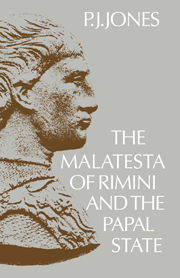Book contents
- Frontmatter
- Contents
- Dedication
- Preface
- Abbreviations
- Map of Romagna and the Marche in the later Middle Ages
- 1 The Papal State and Romagna in the thirteenth century
- 2 Rimini and the rise of the Malatesta
- 3 From commune to papal vicariate
- 4 Galeotto Malatesta, ‘ecclesie pugil’
- 5 The prime of Malatesta rule: Carlo Malatesta
- 6 The pontificate of Martin V
- 7 Sigismondo Pandolfo Malatesta, ‘fex Italiae’
- 8 The papal reconquest
- 9 The government of the Malatesta: I. The papal vicariate
- 10 The government of the Malatesta: II. The signoria
- Appendix
- Bibliography
- Index
2 - Rimini and the rise of the Malatesta
Published online by Cambridge University Press: 23 December 2009
- Frontmatter
- Contents
- Dedication
- Preface
- Abbreviations
- Map of Romagna and the Marche in the later Middle Ages
- 1 The Papal State and Romagna in the thirteenth century
- 2 Rimini and the rise of the Malatesta
- 3 From commune to papal vicariate
- 4 Galeotto Malatesta, ‘ecclesie pugil’
- 5 The prime of Malatesta rule: Carlo Malatesta
- 6 The pontificate of Martin V
- 7 Sigismondo Pandolfo Malatesta, ‘fex Italiae’
- 8 The papal reconquest
- 9 The government of the Malatesta: I. The papal vicariate
- 10 The government of the Malatesta: II. The signoria
- Appendix
- Bibliography
- Index
Summary
Rimini, before the Malatesta, played no remarkable part in the history of either the papal or the Italian city state. Though greater, possibly, than neighbouring towns in size and commercial growth, it rose to no pre-eminence in regional life or politics. Incorporated from the beginning into the States of the Church, first as part of the Maritime Pentapolis, then as the boundary city of Romagna, it became, with Romagna, effectively papal only in the later thirteenth century. Previously, for two hundred years, it was imperial and imperialist, and remained so for as long as the empire continued in Italy to be more than a partisan symbol. In the twelfth century it was quick to embrace the Hohenstaufen interest, fighting on their behalf and accepting the rule of their local counts and margraves. Under Frederick II it welcomed the return of imperial government in 1221, surrendering the contado ontado to the count of Romagna, and allowing an imperial vicecomes to be appointed in the city. Even after the Council of Lyons Rimini continued Ghibelline and only abandoned Frederick when he was routed at Parma in 1248 and Romagna as a whole withdrew allegiance from him. After that it remained a predominantly Guelf community. Its history blends imperceptibly with that of the Guelf Malatesta. And inside the commune the struggle of party is one for local dominion alone.
As a commune, too, Rimini developed along typical lines.
- Type
- Chapter
- Information
- The Malatesta of Rimini and the Papal State , pp. 21 - 41Publisher: Cambridge University PressPrint publication year: 1974



